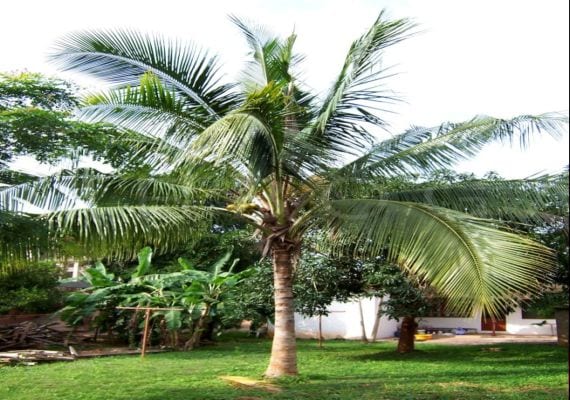
El Cocos nucifera, better known as Coconut tree, is perhaps one of the most popular palm trees and known all over the world. Its elegant bearing and its long leaves transport us to the magnificent tropical beaches. In addition, with the fruit, the coconut, various edible products are made (coconut milk, cakes, ...).
When spring comes in many shopping centers, nurseries, etc. they begin to sell seedlings of this beautiful palm tree. But can it really survive in our area? Let's see the care you need.
The coconut tree has a growth very fast. It can grow to about ten meters high, and its leaves one meter in length.
Needs a minimum temperature of ten degrees, and high humidity. Some specimens - adults - are known to have survived a cold wave that put the thermometers in minus three degrees, but for a very short time. The temperature rose again rapidly to more than ten positive degrees. It does not support the cold, nor the frosts. If we live in a cool climate, in winter it will be convenient to protect it from the cold, indoors with lots of natural light.
We will water it about three times a week, depending on the weather (the more hot and dry, the more frequent waterings). In winter -especially if we live in a cold climate- we will space out the waterings, reducing the frequency to one, maximum two waterings per week.
The substrate must have good drainage. It can be composed of black peat plus perlite, fifty percent, for example. It is advisable to add some vermicompost, horse manure or similar to the mixture.
It is recommended to pay with a specific product for palm trees, from March to October, following the recommendations of the product manufacturer.
Outside, it should be placed at full sun. It can be adapted to semi-shade, but it is a palm tree that likes to feel the direct sun on its leaves. But, if we buy it in a nursery (and especially if it was in a greenhouse for indoor plants) for a few weeks it is recommended to place it in semi-shade, and little by little we can put it in a place where it will have more direct light.
Image - virboga
More information - Decorate your garden with palm trees
I would like to know more about plants and their care I want to work with fruit trees
Hello Fernando.
In the blog you will find a lot of information 🙂 For now, I recommend you click here to know more about fruit trees.
A greeting.
I have an indoor coconut tree and the leaves are turning brown, I don't know why and I don't know what I can do to fix it.
Let's see if someone can help me
Thank you
Hello Maria Elisa.
Most likely, he will start to feel cold, which, added to the indoor conditions, is weakening him. These palm trees do not live well indoors, they need a lot of light, high humidity and temperatures always above 15ºC.
You can fertilize it with a palm tree fertilizer to give it strength and space the waterings, but if your area does not have a mild climate, unfortunately it will end up dying 🙁
A greeting.